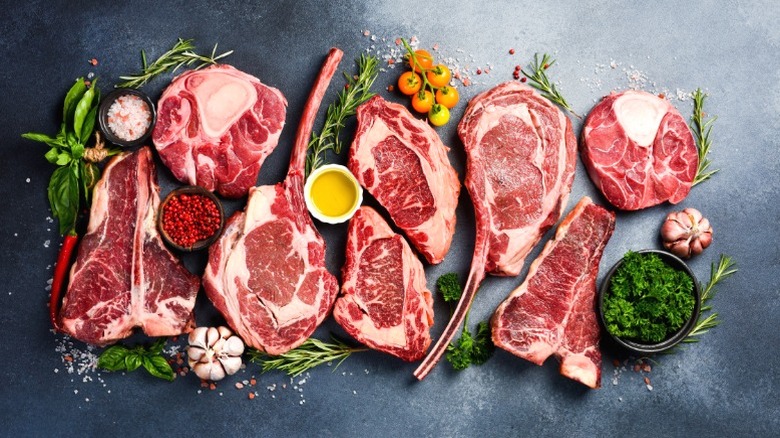The Unique Cooking Method That'll Make Steak Black And Blue
You're probably familiar with the different ways to cook a steak, just as you are with the ways to order a steak. On one end of the spectrum, we have "rare," where the inside of the steak is still red; on the other end of the spectrum, we have "well done," when it has turned gray. For various reasons, people might get mad at you if you order yours that way, not that it stops Donald Trump, who eats his well-done steak with ketchup. But what if you could combine the best (or worst, depending on your perspective) of both worlds? What if you could ensure the interior of the steak was so rare that it might as well be raw, while the exterior was charred to a crisp? That's where Pittsburgh rare, or "black and blue steak," comes in. But what is it, exactly, and how do you make it?
We asked Shawn Matijevich, culinary instructor at the Institute of Culinary Education, and he gave us the skinny. "A black and blue steak is seared screaming hot on the outside. Think charred, crisp, and jet black, and practically raw on the inside. You usually get it that way by blasting the outside with ultra-high heat for 1-2 minutes." It gets its name because, supposedly, Pittsburgh steelworkers would take slabs of steak into work with them and slap them on the molten steel surfaces to cook. Says Matijevich, "Molten steel is just about the temperature you need to get a steak cooked that way, so it makes sense to me. Can I prove it? No."
Choose the right steak (and cook it outside)
So, what should you do if you want to try making this at home? Well, first of all, you'll want to pick the right cut of steak — ideally something thick. "My best advice for making this at home is to find a steak that is at least two inches thick so you have time to get that crust before the inside starts to cook," Matijevich says. As for the precise cut, he gives us a few different options, including some that are perfect for juicy grilling. "Use filet mignon for something lean and tender. This works because this method doesn't let the fat render, so the lean tender meat is still pretty palatable." If you're not put off by a bit of gristle, however, Matijevich recommends a couple of other cuts. "Use a ribeye or New York strip if you're brave and have good teeth."
If you want to cook at home, though, there's one thing you ought to keep in mind. "I wouldn't do it indoors," Matijevich says. With this method, you need to get it seriously, dangerously hot, and that doesn't go well with smoke detectors. "This is going to cause a smell indoors, and when the steak hits, there's going to be a lot of smoke." If you do it outside, though, think about "putting a sheet pan over a gas grill to seal in the heat for a few minutes before throwing it on." And while most steaks are supposed to come to room temperature before you cook them, Matijevich tells us that for this method, "You want it ice cold to start."

